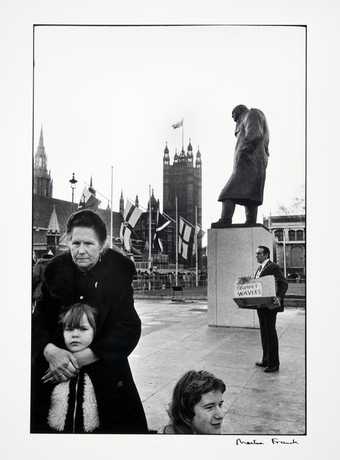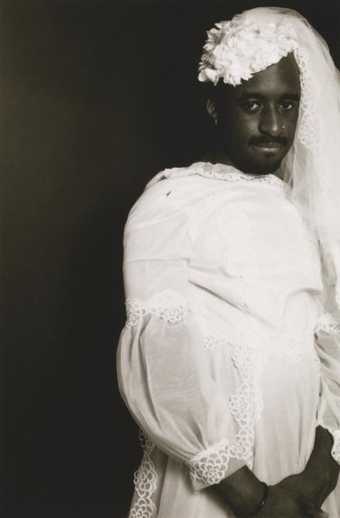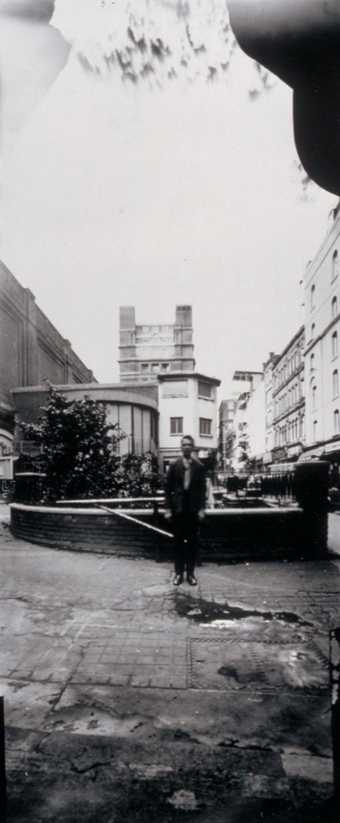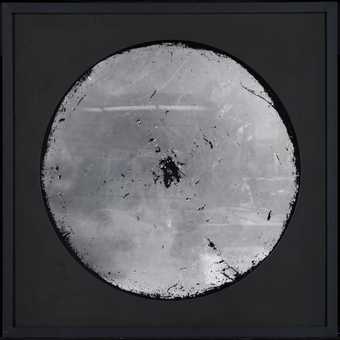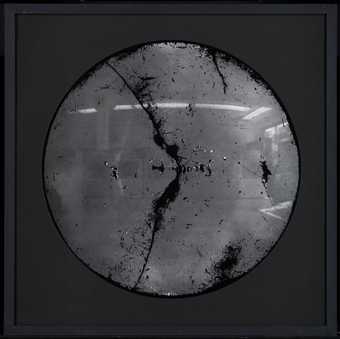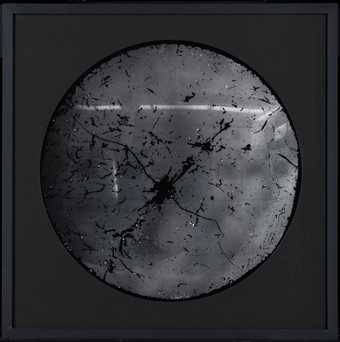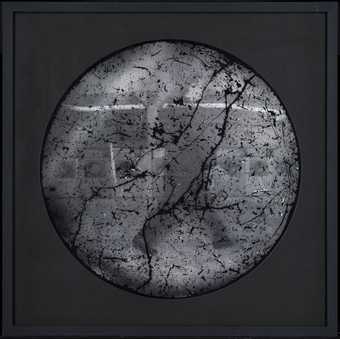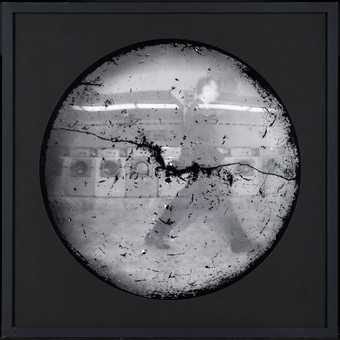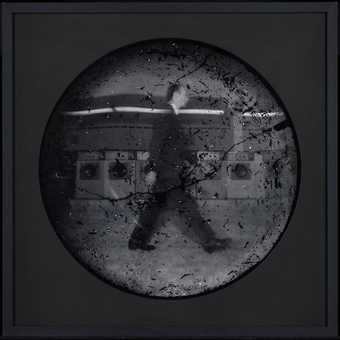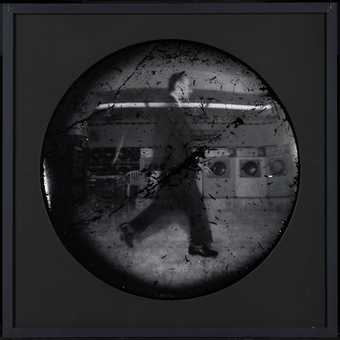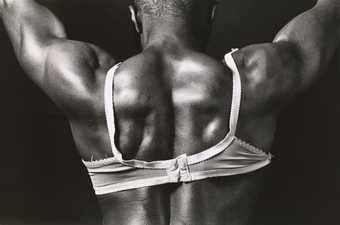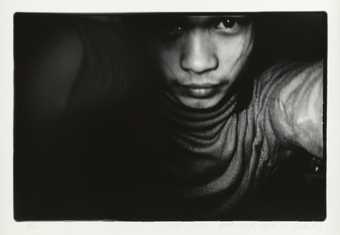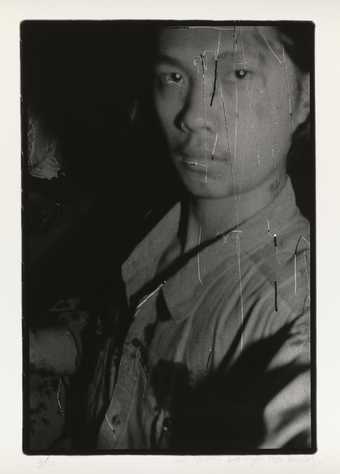
Not on display
- Artist
- Ajamu born 1963
- Medium
- Photograph, gelatin silver print on paper
- Dimensions
- Image: 77 × 51 mm
support: 128 × 83 mm - Collection
- Tate
- Acquisition
- Presented by the Trustees of the Chantrey Bequest 2021
- Reference
- P15461
Summary
Self-Portrait in Wedding Dress 1 1993 (Tate P15460) and Self-Portrait in Wedding Dress 2 1993 are two related small black and white photographs by the British photographer Ajamu. They exist in editions of three, of which Tate’s copies are number three. As the titles suggest, they show the artist wearing a wedding dress, the white fabric of the garment contrasting against his black skin. In Self-Portrait in Wedding Dress 1 Ajamu placed himself on the right side of the frame, leaving a deep-black empty space to the left. He is photographed from the waist upwards, showing just the upper part of the Victorian wedding dress and veil. His pose, with slightly lowered chin and folded hands, suggests a reserved and self-aware subject; his body is slightly turned but his gaze is directed straight into the camera. In Self-Portrait in Wedding Dress 2 the artist portrays himself semi-naked, with the dress pulled down over his buttocks and covering just his legs. He stands in the centre of the frame but is partly turned away from the camera, showing only the left side of his body. He glares into the camera, clasping his arms behind his back.
In both these self-portraits Ajamu has utilised the symbolism of the white wedding dress to draw upon stereotypes around gender, race and class, presenting what he has described as ‘an alternative image’ (in Ajamu X and Naoko Pilgrim 2003, p.108). Ajamu has explained that, during the early and mid-1990s, representations of gay, largely white, men in the media were ‘limited’ and ‘offensive’ and that they directly pushed him to create alternative images, to capture his own desires and fantasies on film (in Ajamu X and Naoko Pilgrim 2003, p.108). By printing the self-portraits on a small scale of two by three inches, Ajamu builds on associations with passport pictures or small family photographs. The size of the prints requires a different way of viewing in the gallery; as the artist has explained, ‘they invite you to come up close to me’ (conversation with Tate curator Mels Evers, 5 September 2019).
These works were shown in Ajamu’s solo exhibition Black Bodyscapes that opened at Camerawork, London in 1994 and continued to tour to Huddersfield Art Gallery and Aytoun Gallery in Manchester. Also included was his now iconic work Bodybuilder in Bra 1990, also in Tate’s collection (Tate P82577). The exhibition was attended by the prominent cultural theorist Stuart Hall who noted:
Ajamu’s bodyscapes face the contradictions of ‘black masculinity’ full-on. They re-figure the black body as the subject of fluid scenes of prohibited pleasure. His approach is openly confrontational and ‘in your face’: he challenges the view to follow him into looking at the extremes of sexual pleasure and desire. His ‘subject’ is queer transgression, and his purpose is to ‘re-claim’ the most far-out of bodily pleasures. Ajamu’s images are provocatively cross-gendered, working for an effect of extreme dissonance.
(Stuart Hall, in Hall and Sealy 2001, pp.44–5.)
Ajamu’s practice centres around the historic and current (in)visibility of the black queer community in the United Kingdom. His photographs often include male models from the artist’s personal circle and most of them were shot in the artist’s studio and home in Brixton, south London. Ajamu has always developed his photographs in his own darkroom and the developing process has increasingly become a central part of his practice. When the artist is not working with models, he often places his own body at the centre of the work, as is the case here, something which results in direct and sometimes confrontational images.
Further reading
Deborah Bright, The Passionate Camera: Photography and Bodies of Desire, London 1998.
Stuart Hall and Mark Sealy, Different: A Historical Context: Contemporary Photographers and Black Identity, London 2001.
Ajamu X and Anita Naoko Pilgrim, ‘In Conversation: Photographer Ajamu and Cultural Critic Anita Naoko Pilgrim’, Paragraph, vol.26, no.1/2, Men’s Bodies, March–July 2003.
Mels Evers
March 2020
Does this text contain inaccurate information or language that you feel we should improve or change? We would like to hear from you.
You might like
-
Martine Franck Princess Anne’s Wedding, Parliament Square
1973, later print -
Ajamu Self-portrait in Wedding Dress 1
1993 -
Steven Pippin Self-Portrait with Photo Booth
1987 -
Steven Pippin Laundromat-Locomotion (Walking in Suit)
1997 -
Steven Pippin Laundromat-Locomotion (Walking in Suit)
1997 -
Steven Pippin Laundromat-Locomotion (Walking in Suit)
1997 -
Steven Pippin Laundromat-Locomotion (Walking in Suit)
1997 -
Steven Pippin Laundromat-Locomotion (Walking in Suit)
1997 -
Steven Pippin Laundromat-Locomotion (Walking in Suit)
1997 -
Steven Pippin Laundromat-Locomotion (Walking in Suit)
1997 -
Steven Pippin Laundromat-Locomotion (Walking in Suit)
1997 -
Ajamu Body Builder in Bra
1990 -
RongRong Self-Portrait
1994 -
RongRong Self-Portrait
1994 -
RongRong Self-Portrait
1995

